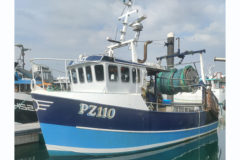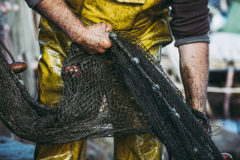Andy Read reports on training innovations at the Scottish Maritime Academy
I visited the Scottish Maritime Academy in Peterhead last month whilst one of the ‘hybrid’ sessions for the Class II ticket was taking place. Linda Hope, manager of the centre, one of a number of training facilities run by North East Scotland College, told me: “Although we were warned ‘never do remote’, and we didn’t during the first lockdown, the ‘hybrid’ model that we are using has proven to be very successful.
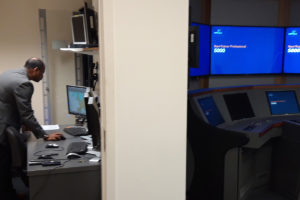
Curriculum manager Shubham Chowdhury preparing the simulator for two trips into harbour, one by a large merchant vessel through busy shipping lanes in Hong Kong, the second taking a fishing boat into Peterhead harbour in a nasty swell.
“Those that want the full hands-on experience for their Class II can still receive this. Other students – as far away as Brixham in one case – can get real-time learning by logging into the classroom, with the same level of personal support available from lecturers, but without the travel costs associated with making it to Peterhead.
“It has worked very well for Class II entrants, and we hope to start the same approach for a new intake working towards their Class I tickets as well.”
Situated on the southeastern corner of Peterhead harbour, in a striking building with state-of the-art facilities, the academy has intakes looking at careers in all aspects of the maritime domain, from workboats through to the fishing industry, wind cats and the merchant navy.
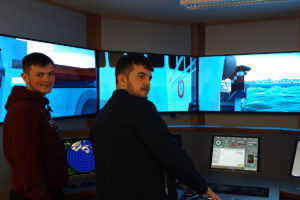
Aidan West from the Virtuous and Ryan Hogarth from the Victoria May, on the helm of the simulator. The ‘wheelhouse’ includes provision for monitoring trawl configuration when turning and working in bad weather, operation of deck machinery, and using a sounder to monitor for potential seabed fasteners and take evading action.
Linda Hope said: “One of the good aspects now of the training we offer is that is it applicable across the maritime sector. Although a lot of the entrants we have for the Class II and Class I tickets are well established in the industry, and have a very good idea which vessels they will be using their tickets on, this isn’t the case for our new entrants, especially those that don’t come from fishing backgrounds.
“New entrants start with a 12-week course in Maritime Studies that allows them to make a start in any of the offshore industries. The percentage moving into fishing is gradually rising, and with the demand from fishing, wind farm industries and the merchant navy, we are able to tell prospective entrants that if they pass the 12-week course, they are virtually guaranteed a job.
“As they move on with other tickets too, the recognition of qualifications across sectors means that they can switch between sectors if they wish. The fishing qualifications are in the process of alignment with STCW-F tickets, making the qualifications that much more valuable.
“The value of these entrants to the industry is recognised by Peterhead Port Authority, which supports the trainees through provision of the PPE needed, as well as sponsoring their fees for the mandatory one-day safety certificates that all new entrants need.”
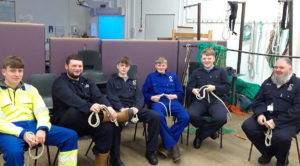
New entrants being shown the ropes by academy lecturer Michael Dyke. From left: Euan Duncan, Connor Mackintosh, Finlay Bremner, Stephen Poots and Ellis Mearns.
During a brief interruption to the training of the new entrants when I visited, a quick show of hands showed that a majority were aiming to move into the fishing industry, some on family boats and others still deciding what type of fishery they might like to try.
Moving into the simulator classroom, Linda said that this was the most popular part of the tour for the visits that the academy hosts from primary and secondary schools in the region.
“We like to bring in children at an early age, so that they become aware that a maritime career, be it in the merchant fleet or in fishing, is a viable career choice, and one with many options within it.
“The children just love the simulator, especially when we set it up to some sort of crisis, in bad weather. With the screens being so clear, many of them actually feel as if they are at sea, even though the floor in the simulated bridge doesn’t move at all!

Linda Hope, manager of the Scottish Maritime Academy. “We can almost guarantee job offers for our young entrants completing the initial 12-week training course.”
“It is also a highly valued part of the service we can offer to commercial companies, who typically book simulator courses for three to five days of bespoke training for their crew. We have a wide range of simulations we can offer, all the way through to emergency helicopter evacuations, with horns blaring, atrocious weather, static interference and the like.
“Customers can even monitor the stress that their crew are under, and how they cope with this stress, and offer support in coping with situations like this. Having this advance training in the simulator can be lifesaving, as and when trainees encounter this type of situation in real life.
“Covid meant that we lost much of this bespoke commercial income, but we are seeing it return now.”
In the simulator classroom, curriculum manager Shubham Chowdhury showed me into the control room at the side, where he was loading up two scenarios for Class II trainees Aidan West and Ryan Hogarth.
“I’m completely out of sight during simulations, although I can see how they cope with the different scenarios, and adjust the situation in real time – for example, by creating a breakdown of a piece of equipment, or another vessel failing to obey the rules of the road.
“We have simulations for loading cargo, or hauling fishing gear, that are very realistic and can be a great help in bringing our young skippers on. We can also monitor the stress levels of the trainees, and get a feel for how they are coping with particular scenarios. Where they find a particular challenge, we can spend more time on this, and help them gain confidence.
“It’s an invaluable tool, one that really is the jewel in the crown for the offer we can make at the academy.”
This story was taken from the latest issue of Fishing News. For more up-to-date and in-depth reports on the UK and Irish commercial fishing sector, subscribe to Fishing News here or buy the latest single issue for just £3.30 here.




